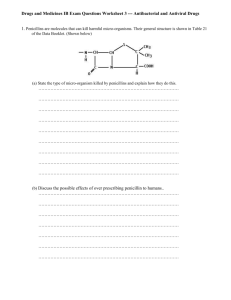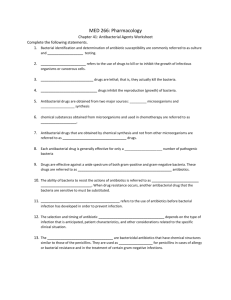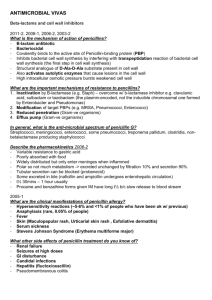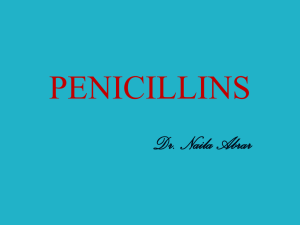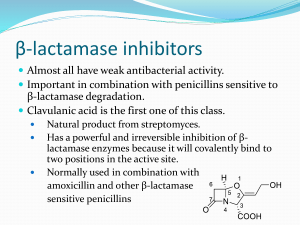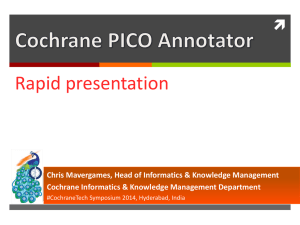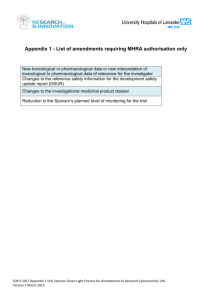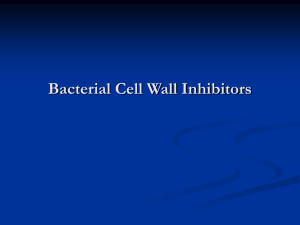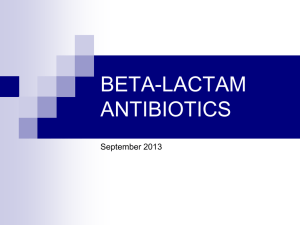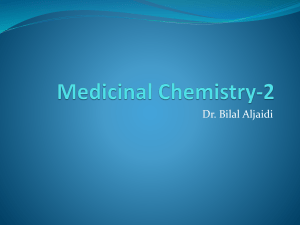pharmacology_3
advertisement
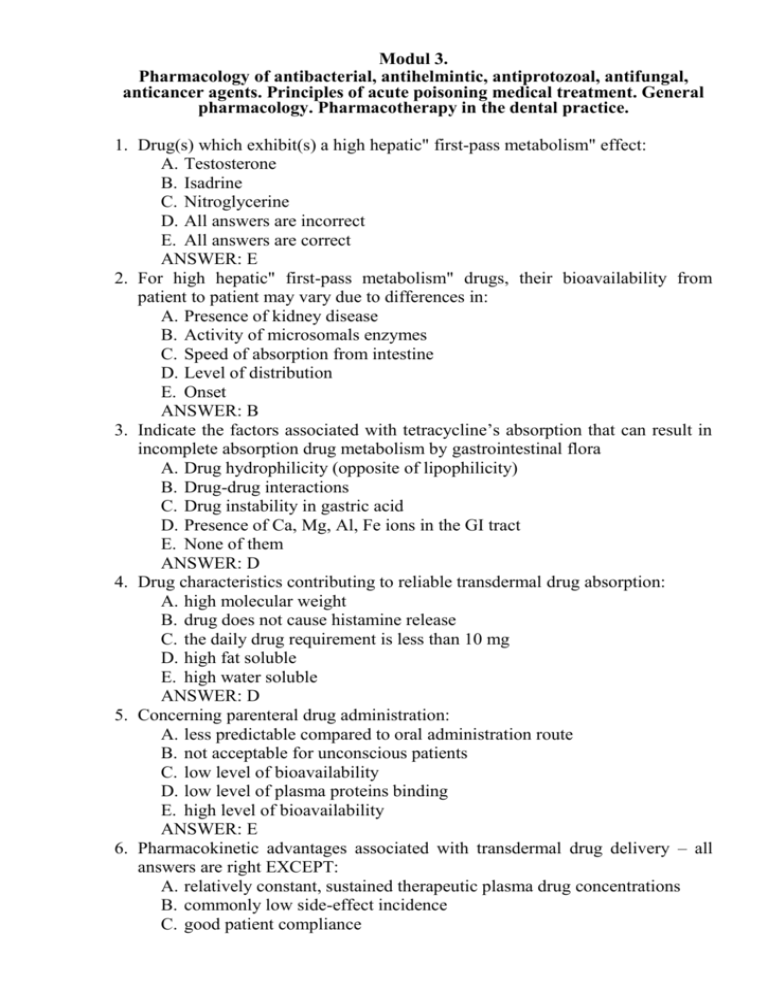
Modul 3. Pharmacology of antibacterial, antihelmintic, antiprotozoal, antifungal, anticancer agents. Principles of acute poisoning medical treatment. General pharmacology. Pharmacotherapy in the dental practice. 1. Drug(s) which exhibit(s) a high hepatic" first-pass metabolism" effect: A. Testosterone B. Isadrine C. Nitroglycerine D. All answers are incorrect E. All answers are correct ANSWER: E 2. For high hepatic" first-pass metabolism" drugs, their bioavailability from patient to patient may vary due to differences in: A. Presence of kidney disease B. Activity of microsomals enzymes C. Speed of absorption from intestine D. Level of distribution E. Onset ANSWER: B 3. Indicate the factors associated with tetracycline’s absorption that can result in incomplete absorption drug metabolism by gastrointestinal flora A. Drug hydrophilicity (opposite of lipophilicity) B. Drug-drug interactions C. Drug instability in gastric acid D. Presence of Ca, Mg, Al, Fe ions in the GI tract E. None of them ANSWER: D 4. Drug characteristics contributing to reliable transdermal drug absorption: A. high molecular weight B. drug does not cause histamine release C. the daily drug requirement is less than 10 mg D. high fat soluble E. high water soluble ANSWER: D 5. Concerning parenteral drug administration: A. less predictable compared to oral administration route B. not acceptable for unconscious patients C. low level of bioavailability D. low level of plasma proteins binding E. high level of bioavailability ANSWER: E 6. Pharmacokinetic advantages associated with transdermal drug delivery – all answers are right EXCEPT: A. relatively constant, sustained therapeutic plasma drug concentrations B. commonly low side-effect incidence C. good patient compliance D. suitable for prevention of acceleration of disease E. extremely shot onset ANSWER: E 7. Routes of administration that avoid "first-pass metabolism" hepatic effects – all answers are right EXCEPT: A. sublingual B. oral C. transdermal D. rectal suppositories E. inhalation ANSWER: B 8. A patient with gingivitis was prescribed a gargle with antiseptic. Its properties are determined by atomic oxygen that slivers in presence of organic substances. Name this drug A. Sodium bicarbonate B. Chlorhexidine bigluconate C. Potassium permanganate D. Ciprofloxacin E. Dygitoxinum ANSWER: C 9. A man in comatose after craniocerebral trauma has diminished breath sounds, thread pulse, reflexes are absent. What route of medicine introduction is the most suitable in this case? A. Inhalation B. Oral C. Intravenous D. Rectal E. Subcutaneous ANSWER: C 10.A patient who has been ill with tuberculosis for a long time has an intracellular mycobacterium disposition. What preparation must be included into the complex therapy of tuberculosis? A. Ciprofloxacin B. Atropine sulphate C. Isoniazide D. Sodium bicarbonate E. Ethambutol ANSWER: C 11.A patient was poisoned with organ phosphorous compounds. What preparations should be included into complex therapy? A. Nalorphine hydrochloride B. Atropine sulphate C. Tetacin-calcium D. Bemegride E. Glucose ANSWER: B 12.What solution is used for mechanical wound cleansing and has antiseptic effect? A. Calcium chloride B. Natrium chloride C. Hydrogen peroxide D. Potassium chloride E. Chloramines ANSWER: C 13.What medicine can be used to accelerate formation of connective tissue matrix for healing fracture? A. Cyclophosphan B. Cyclosporine C. Methotrexate D. Methyluracil E. Prednisolone ANSWER: D 14.Woman during the pregnancy was non-systematically taking antibiotics. The child's dentist examination showed incisor destruction, yellow enamel, and brown limbs of dental cervix. What medicine was mother taking? A. Doxycycline B. Ampicilline C. Furosemide D. Octadine E. Nitroglycerine ANSWER: A 15.A 40 year old HIV positive patient is receiving HAART regimen (Highly active anti-retroviral therapy). Which one of the antiretroviral following drugs he takes? A. All the above B. Indinavir C. Efavirenz D. None the above E. Nelfinavir ANSWER: A 16.HIV positive patient is receiving Highly active anti-retroviral therapy. Which one of the antiretroviral drugs he can take? A. Rifampicin B. Epinephrine C. Stavudine D. Atropine E. Ketoconazole ANSWER: C 17.Which one of the following is a common early side effect of Penicillin? A. Constipation B. Hypertension C. Orthostatic hypotension D. Atrioventricular block E. Skin rash ANSWER: E 18.Doxycycline is used: A. for Pneumonia B. for the prevention of TB C. for the prevention of malaria D. for the prevention of leprosy E. for the treatment of HIV-infection ANSWER: A 19.A 33 years old male patient has been diagnosed Mycoplsma pneumoniae infection. He was treated by one of the broad spectrum antibacterial drug group tetracycline for 21 days. What may be most appropriate toxicity? A. alopecia B. sleeplessness C. nausea, vomiting D. hypotension E. tuberculosis ANSWER: C 20.A 25 year old male has a cough and low grade fever since the last 3 months. Laboratory tests show sputum positive for acid fast bacteria (tuberculosis). Which of the following combination of drugs is most likely to be administered at the start to this patient? A. Streptomycin, Isoniazide, Rifampicin and Pyrazinamide B. Pyrazinamide and Rifampicin C. Penicillin and Isoniazide D. Rifampicin alone E. Streptomycin alone ANSWER: A 21.A patient has been given treatment for pulmonary tuberculosis for 2 months as initial phase. Now he comes for medication for the continuation phase. Which of the following drugs will he most likely be given for the continuation phase? A. Pyrazinamide and norfloxacin B. Streptomycin, Isoniazide, Rifampicin and Pyrazinamide C. Isoniazide and Rifampicin D. Rifampicin alone E. Pyrazinamide alone ANSWER: C 22.A young man 26 years old is started treated for pulmonary tuberculosis. He comes to the physician after 1 week with complaint of orange red colored urine and sweat and tears. Which of the following drugs is most likely causing these symptoms? A. Streptomycin B. Rifampicin C. Ethambutol D. Pyrazinamide E. Thiacetazone ANSWER: B 23.A 30 year old male with known tuberculosis infection and taking medication since 1 month comes to the phisician with complaint of visual disturbances including decreased visibility and slight color blindness. If these symptoms are due to his drug treatment, which one of the following antituberculosis drugs is most likely the cause of his symptoms? A. Streptomycin B. Ethambutol C. Cephalexin D. Atropine E. Penicillin ANSWER: B 24.A 35 year old male recently diagnosed with tuberculosis and is started on medication. After a few days he comes to the emergency department a few hours after taking a meal at McDonald’s with severe pain in the big toe. Blood tests show a very high uric acid level. Which of the following antituberculosis drugs most likely caused these symptoms? A. Streptomycin B. Cephalexin C. Atropine D. Penicillin E. Pyrazinamide ANSWER: E 25.A 35 year old female taking medication for tuberculosis and oral contraceptives comes to the Gynaecology with complaint of amenorrhea. Laboratory test shows a positive pregnancy test. Which one of the following antituberculosis drug most likely caused her to become pregnant? A. Rifampicin B. Cephalexin C. Atropine D. Penicillin E. Streptomycin ANSWER: A 26.A 48 year old male is diagnosed with tuberculosis and has been treated for 2 months with Isoniazide and rifampicin with good response. But the patient develops numbness and paresthesias in the extremities. What will you most likely do next? A. Add pyridoxine B. Nothing C. Add vitamin E D. Replace rifampin with ethambutol E. Replace Isoniazide with streptomycin ANSWER: A 27.A 50 year old patient comes to the emergency department, a day after he has been administered an antibiotic for an on-going infection, with complaint of palpitations. ECG reveals prolonged QT interval. Which one of the following Fluoroquinolones most likely caused this adverse effect? A. Cephalexin B. Atropine C. Penicillin D. Streptomycin E. Gatifloxacin ANSWER: E 28.Hydrogen peroxide A. acts by oxidizing the cell membrane of microorganisms B. is used in hospitals to disinfect surfaces C. A 3% solution is also used as an antiseptic D. It is oxidazing agent E. All the above ANSWER: E 29.Clinical uses of immunosuppressive drugs: A. organ transplantation B. autoimmune hemolytic anemia C. autoimmune disorders D. A and C E. A, B and C ANSWER: E 30.The process by which drugs influence toward cell physiology is called: A. Pharmacokinetics B. Pharmacotherapeutics C. Pharmacodynamics D. Pharmacology E. All answers are correct ANSWER: C 31.Another name for biotransformation of a drug is: A. Absorption B. Dilution C. Excretion D. Metabolism E. All answers are correct ANSWER: D 32.Drugs given by which routes are altered by the first-pass effect? A. Sublingual B. Subcutaneous C. Oral D. Intravenous E. All answers are correct ANSWER: C 33.Patients with renal failure would most likely have problems with drug: A. Excretion B. Absorption C. Metabolism D. Distribution E. None the above ANSWER: A 34.Indicate the adverse effects related to morphine sulphate A. Decreased peristalsis B. All the above C. Delayed gastric emptying D. Common bile duct spasm E. Vomiting ANSWER: B 35.A patient has been admitted after overdosing on acetaminophen (Tylenol), with a total ingested dose of 14 g. The nurse plans to monitor this patient for development of which of the following signs and symptoms related to the overdose A. Renal failure B. Kidney stones C. Acute hepatic necrosis D. Metabolic alkalosis E. None the above ANSWER: C 36.Which medication is prescribed for treatment of an acetaminophen overdose? A. naloxone B. acetylcysteine C. methylprednisolone D. vitamin K E. None the above ANSWER: B 37.A 23-year-old has been taken to the emergency room for a suspected overdose of morphine tablets. Which agent may be used to treat this overdose? A. Dimedrol B. Epinephrine C. Aspirin D. Naloxone E. Atropine ANSWER: D 38.Most nonsteroidal anti-inflammatory drugs (NSAIDs) work by: A. Ameliorating pain perception B. Inhibiting prostaglandin production C. Increasing blood flow to painful areas D. Increasing the supply of natural endorphins E. None answer is correct ANSWER: B 39.In assessing a patient for the most serious signs and symptoms of acetaminophen toxicity, what indices should be monitoring? A. Vital signs B. Electrolytes C. Level of consciousness D. Liver enzymes E. None answer is correct ANSWER: D 40.The advantage of cyclooxygenase-2 (COX-2) inhibitors over other NSAIDs is that they: A. Have a longer duration of action B. Are less likely to cause hepatic toxicity C. Do not decrease the cytoprotective mehanism of the stomach mucosa D. Have a more rapid onset of action E. None the above ANSWER: C 41.Chooser the correct statement about allopurinol: A. "Do not take this medication during an acute attack of gout." B. "Include salmon and organ meats in your diet on a weekly basis." C. "Take the medication with an antacid to minimize GI distress." D. "This medication may cause your urine to turn orange." E. None the above ANSWER: A 42.Misoprostol (Cytotec) is contraindicated which of the following conditions? A. COPD B. Gastroesophageal reflux disease (GERD) C. Pregnancy D. Peptic ulcer E. None the above ANSWER: C 43.A patient receiving rifampin must be told that: A. A nonharmful side effect of the drug is red-orange discoloration of urine, sweat, and tears. B. Oral contraception is the preferred method of birth control when using rifampin. C. Peripheral neuropathy is an expected side effect, and the patient should report any numbness or tingling of the extremities. D. The patient will only need to take this medication for the prescribed 14day period. E. None the above ANSWER: A 44.What would you expect for a patient who is taking INH (Isoniazide)? A. Urine and saliva may be reddish-orange in color B. Pyridoxine may be needed to prevent neurotoxicity C. Injection sites should be rotated daily D. Take medications with an antacid to reduce gastric distress E. None the above ANSWER: B 45.Drug therapy as the treatment for active tuberculosis may need to last up to: A. 6 months B. 12 months C. 24 months D. a lifetime. E. 24 weeks ANSWER: C 46.Why are multiple medications used in the drug regimen for tuberculosis? A. It reduces the possibility of the microorganism becoming drug-resistant B. It ensures a 99% cure of the disease C. Starting drug therapy early on will reduce symptoms immediately D. Patient compliance is better with multiple medications E. All the above ANSWER: A 47.Which of the following drugs would the physician prescribe to the patient who has been diagnosed with genital herpes? A. amantadine B. acyclovir (Zovirax) C. zidovudine (Retrovir) D. ribavirin (Virazole) E. epinephrine ANSWER: B 48.Medications used to treat human immunodeficiency virus (HIV) infections are classified as: A. Antifungal agents B. Nonretroviral agents C. Antiretroviral agents D. Antiparasitic agents E. None the above ANSWER: C 49.Effectiveness of antiviral agents administered to treat HIV infection is evaluated by periodic assessment of: A. Megakaryocytes B. Red blood cell counts C. Lymphocyte counts D. Viral load E. None the above ANSWER: D 50.Which of the following types of antiviral agents are used to treat HIV infection? A. Nonnucleoside reverse transcriptase inhibitors B. Protease inhibitors C. Reverse transcriptase inhibitors D. Fusion inhibitors E. All answers are correct ANSWER: E 51.Amantadine is only active against: A. Cytomegalovirus. B. influenza A C. Hepatitis B D. varicella-zoster E. All the above ANSWER: B 52.General adverse effects of chemotherapy include which of the following? A. Leukocytosis B. Thrombocytopenia, alopecia C. Urinary retention D. Bronchospasm E. Constipation ANSWER: B 53.Combinations of chemotherapeutic agents are frequently used for all of the following purposes EXCEPT: A. Preventing drug resistance B. Providing a synergistic action C. Decreasing cost of treatment D. Decreasing the severity of adverse effects E. None all the above ANSWER: C 54.Which of the following adverse effects related to cisplatin (Platinol)? A. Nephrotoxicity B. Peripheral neuropathy C. Severe nausea/vomiting D. Diarrhea E. All the above ANSWER: E 55.A major dose-limiting side effect of doxorubicin (Adriamycin) is: A. Hemorrhagic cystitis B. Cardiomyopathy C. Hepatoxicity D. Nephrotoxicity E. None answer is correct ANSWER: B 56.A common drug used to treat Candida infections is: A. Nystatin B. oseltamivir C. amantadine D. griseofulvin E. Penicillin ANSWER: A 57.Which of the following antifungal agents can be given intravenously to treat severe yeast infections as well as a one-time oral dose to treat vaginal yeast infections? A. doxorubicin B. voriconazole C. fluconazole (Diflucan) D. oseltamivir E. amantadine ANSWER: C 58.Which medication is often used as a 1-day dose treatment of vaginal candidiasis? A. doxorubicin B. voriconazole C. fluconazole (Diflucan) D. oseltamivir E. amantadine ANSWER: C 59.If tetracycline is administered to children less than 8 years of age, it can cause: A. Ototoxicity B. Neurotoxicity C. GI bleeding D. Permanent discoloration of the teeth E. None the above ANSWER: D 60.A patient who is allergic to penicillin is at increased risk for an allergy to: A. tetracycline B. cefazolin C. gentamycin D. erythromycin E. doxorubicin ANSWER: B 61.You should assess a 75-year-old patient for nephrotoxicity and ototoxicity when administering which of the following antimicrobials? A. cefazolin (a cephalosporin antibiotic) B. clindamycin (a lincosamide antibiotic) C. gentamicin (an aminoglycoside antibiotic) D. erythromycin (a macrolide antibiotic) E. penicillin ANSWER: C 62.Indicate the adverse effects of non-steroidal anti-inflammatory drugs A. Gastric pain, anorexia, nausea, vomiting B. Bleeding C. Renal impairment D. Fluid retention E. All the above ANSWER: E 63.Choose the antineoplastic drug: A. Cyclophosphamide B. Chlorambucil C. Doxorubicin D. Methotrexate E. All the above ANSWER: E 64.Indicate the adverse effects of cytotoxic drugs: A. Emesis B. Oral mucositis C. Diarrhea D. Neutropenia E. All the above ANSWER: E 65.Indicate the pharmacological group of Cyclophosphamide: A. cytotoxic drugs B. non-steroidal anti-inflammatory drugs C. antibiotics D. diuretics E. beta-adrenoblockers ANSWER: A 66.Beta-lactams antibiotics include: A. Penicillins B. Cephalosporins C. Carbapenems D. Monobactams E. All the above ANSWER: E 67.Indicate the antibiotic from aminoglycosides: A. Gentamycin B. Amikacin C. Tobramycin D. Streptomycin E. All the above ANSWER: E 68.Choose the correct statement about glycopeptides A. Vancomycin is glycopeptide antibiotic B. Effective against staphylococci resistant to other drugs, including MRSA C. Teicoplanin is glycopeptide antibiotic D. All the above E. None of the above ANSWER: D 69.Indicate the antitubercular drugs: A. Rifampicin B. Isoniazide C. Rifabutin D. Streptomycin E. All the above ANSWER: E 70.Absorption of what antibiotics is impaired by iron, zinc or calcium in the stomach: A. Tetracyclines, B. Quinolones, C. Antiretroviral drugs, D. Mcholinoblockers A. A and D B. A and B C. A, B, C D. All the above E. None of the above ANSWER: B 71.Courses of penicillins are complicated by: A. Allergic reactions B. Diarrhoea C. Convulsions D. All the above E. None of the above ANSWER: D 72.Choose the drugs could damaging the innerear: A. Gentamycin B. Vancomycin C. Cisplatin D. Furosemide E. All the above ANSWER: E 73.“Antabuse-like” reactions may occur in susceptible people if they take an alcohol with anti-microbials like: A. Metronidazole B. Furosemide C. Penicillin D. Gentamycin E. All the above ANSWER: A 74.Indicate the pharmacological group of Cefuroxime A. Penicillins B. Cephalosporins C. Microlides D. Antifungal drugs E. Antiviral drugs ANSWER: B 75.Indicate the pharmacological group of Cephalexin A. Penicillins B. Cephalosporins C. Microlides D. Antifungal drugs E. Antiviral drugs ANSWER: B 76.Indicate the pharmacological group of Cefotaxime (Claforan) A. Penicillins B. Cephalosporins C. Microlides D. Antifungal drugs E. Antiviral drugs ANSWER: B 77.Indicate the pharmacological group of Ceftriaxone A. Penicillins B. Cephalosporins C. Microlides D. Antifungal drugs E. Antiviral drugs ANSWER: B 78.Indicate the pharmacological group of Oxacillin A. Penicillins B. Cephalosporins C. Microlides D. Antifungal drugs E. Antiviral drugs ANSWER: A 79.Indicate the pharmacological group of Piperacillin A. Penicillins B. Cephalosporins C. Microlides D. Antifungal drugs E. Antiviral drugs ANSWER: A 80.Indicate the pharmacological group of Dicloxacillin A. Penicillins B. Cephalosporins C. Microlides D. Antifungal drugs E. Antiviral drugs ANSWER: A 81.Indicate the pharmacological group of Gentamicin A. Penicillins B. Cephalosporins C. Microlides D. Aminoglycoside E. Antiviral drugs ANSWER: D 82.Indicate the pharmacological group of Kanamycin A. Penicillins B. Cephalosporins C. Microlides D. Aminoglycoside E. Antiviral drugs ANSWER: D 83.Indicate the pharmacological group of Streptomycin A. Penicillins B. Cephalosporins C. Microlides D. Aminoglycoside E. Antiviral drugs ANSWER: D 84.Indicate the pharmacological group of Tobramycin A. Penicillins B. Cephalosporins C. Microlides D. Aminoglycoside E. Antiviral drugs ANSWER: D 85.Indicate the pharmacological group of Gatifloxacin A. Penicillins B. Cephalosporins C. Microlides D. Fluoroquinolones E. Antiviral drugs ANSWER: D 86.Indicate the pharmacological group of Lomefloxacin A. Penicillins B. Cephalosporins C. Microlides D. Fluoroquinolones E. Antiviral drugs ANSWER: D 87.Indicate the pharmacological group of Norfloxacin A. Penicillins B. Cephalosporins C. Microlides D. Fluoroquinolones E. Antiviral drugs ANSWER: D 88.Indicate the pharmacological group of Azithromycin A. Penicillins B. Cephalosporins C. Microlides D. Fluoroquinolones E. Antiviral drugs ANSWER: C 89.Indicate the pharmacological group of Clarithromycin A. Penicillins B. Cephalosporins C. Microlides D. Fluoroquinolones E. Antiviral drugs ANSWER: C 90.Indicate the pharmacological group of Erythromycin A. Penicillins B. Cephalosporins C. Microlides D. Fluoroquinolones E. Antiviral drugs ANSWER: C 91.Choose the common adverse effects of penicillins antibiotics A. Hypersensitivity—anaphylaxis, serum sickness, skin rash, urticaria B. Superinfection C. Nausea and vomiting D. Diarrhea, colitis, pseudomembranous colitis E. All the above ANSWER: E 92.The bacteriostatic antibiotics are: A. Microlides, B. Penicillins, C. Tetracyclines, D. Aminoglycosides A. A and D B. A and C C. A, B, C D. All the above E. A, B, D ANSWER: B 93.The bactericidal antibiotics are: A. Microlides, B. Penicillins, C. Tetracyclines, D. Aminoglycosides A. A and D B. B and D C. A, B, C D. All the above E. A, B, D ANSWER: B 94.What is the reason for combining clavulanate, sulbactam, or tazobactam with a penicillin? A. To bind and inactivate the beta-lactamase enzymes produced by many bacteria (eg, E. coli, Klebsiella, Enterobacter, and Bacteroides species, and S. aureus) B. To protect the penicillin from destruction by the enzymes C. To extend the penicillin’s spectrum of antimicrobial activity D. The combination of drug may be effective in infections caused by bacteria that are resistant to a beta-lactam antibiotic alone E. All the above ANSWER: E 95.Indicate the combining drug of penicillin and beta-lactamase inhibitors A. Unasyn B. Timentin C. Augmentin D. All the above E. None the above ANSWER: D 96.Aminoglycosides: A. are bactericidal agents B. are poorly absorbed from the gastrointestinal tract C. are well absorbed from intramuscular injection sites D. are nephrotoxic and ototoxic E. all the above ANSWER: E 97.Fluoroquinolones are not recommended for use in children because A. they have been associated with permanent damage in cartilage and joints B. they can cause allergic reaction C. they are bactericidal agents D. they are bacteriostatic agents E. All the above ANSWER: A 98.With aminoglycosides, observe for: A. Nephrotoxicity B. Ototoxicity C. Neurotoxicity (respiratory paralysis) D. Nausea, vomiting, diarrhea E. all the above ANSWER: E 99.With fluoroquinolones, observe for: A. Hepatotoxicity (abnormal liver enzyme tests, hepatitis, hepatic failure) B. Allergic reactions (anaphylaxis, urticaria) C. Nausea, vomiting, diarrhea, pseudomembranous colitis D. Photosensitivity (skin redness, rash, itching) E. all the above ANSWER: E 100. A tetracycline is the drug of choice A. Brucellosis B. Cholera C. Chlamydia infection D. Trachoma E. all the above ANSWER: E
